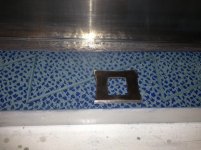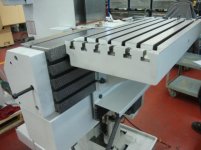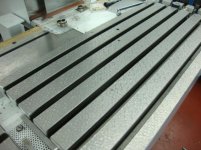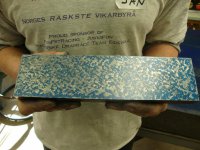I eyeball it, I have never did a scientific study and measured it with a caliber, some other ambitious person can do that. I suppose one could scribe lines making squares on a piece of plexiglass and calculate it more accurately. But i am not into the scientific side of it, just the mechanical side of it. I can see a Sheldon Cooper type person doing it. :-) In a perfect world you would have the same size square cut low spot next to a same size square high spot.
You should read about air bearings: Much of what I teach and lecture about is from information I have discussed with The Arneson Brothers at Professional Instruments (My Dad and I had been scraping machines for them them for years, plus I taught their guys to use the BIAX after some had worked with Moore scraping Moore testers)) before I was asked to speak at the IMTS / SME show in Chicago several years ago. I was all shook up when I heard Professors were going to be in the audience. I went over to Professional Instruments and they told me about The rotation of points and the Kinemedic Mount Principle. I had always known them as "hinge" and 3 points. But I wanted to impress the professors.
I am a simple man who is a Tradesman, i don't go into the depth of the "whys and how comes", I leave that to the scientists to think about. I just know how to scrape ways and use wearstrips to the best advantage in machine tool rebuilding and building.
It must work and be correct as I keep getting asked to teach at professional machine builders world wide. They have PHD's that understand one needs to take baby steps in all of this before they can run. I am a simple man as my dad was and not a college educated engineer or scientist. But they ask me to show them how the tradesman of old did his craft.
Years ago Cincinnati tried to eliminate scraping and used ground and slotted plates to get 50% on their Versa Power machines that failed miserably as the slots acted like a files and wore away the hardened ways it rode on. Times change and new technologies come along like linear ways, but at Quaser Machine in Taiwan..
??????????.. they build super precision linear guide way machines but they still scrape the mount surfaces after the are precision milled and ground first. Also scrape the ball screw mounts and under the column to get precision alignment to the table. I taught scraping classes there back in 2010.
You can read more about the other side of what I teach: at these sites They have tons of reference material Sheldon Cooper would love to read.
Bearing Analysis | Professional Instruments Company and Here is Drew DeVitt's company where he first experimented with Moglice to make air bearings.
NEWWAY Air bearings | Frictionless Motion
Enjoy, Rich
Pictures: L to R ; My assistant teacher Ted (masters degree in Engineering) at PMC, Precision Research Institute in Taichung Taiwan experimenting and testing on scraping 50% - 20 PPI on Turcite . Using the BIAX 1" Square Control Gage to count and eyeball measure the percentage of contact. Square cut scraping on Machine in Germany at my recent class at a Machine Rebuilder.



















